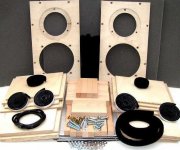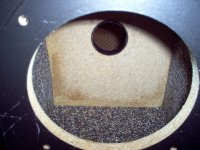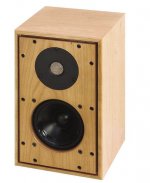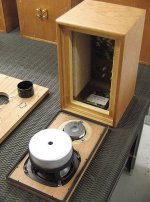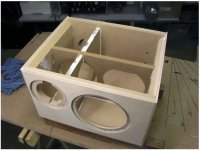But we're talking of very low frequencies with very long wavelengths. As long as the cabinet is not very large, it is absolutely valid to assume 180°. Maybe at 100 Hz it is 179°, but who cares? Of course, the panels will move less at the edges than in the middle, but the direction is always the same.
And I never said that they cancel out. But the bass output will be reduced a certain amount. How much depends surely of internal volume, size of panels, thickness of panels, and so on.
And I never said that they cancel out. But the bass output will be reduced a certain amount. How much depends surely of internal volume, size of panels, thickness of panels, and so on.
ofcourse the panels cannot move in unity with the cone
and the result might be what you would call chaotic, and end up ressonating
and the result might be what you would call chaotic, and end up ressonating
Must be very difficult to understand: at low frequencies you can neglect any phase errors between cone and panel.
Actually 12mm quality ply has about the same rigidity as typical 20mm MDF.
dave
Hi, If your talking stiffness that is completely impossible, as its a cubic function, rgds, sreten.
And one thing to get straight is there is no attempt to critically damp the resonances,
just reduce them to an acceptable level. In the low bass the box will "balloon" related
to inherent panel stiffness, but the out of phase output hardly cancels the driver, hardly
changes box parameters and causes no colouration whatsoever, just a mild loss.
Last edited:
Hi,
Unfortunately its not that simple. Smaller boxes (like the LS3/5A)
don't have very thin walls and lots of mass loading to take the
resonances below a typical cut-off, say 200Hz.
The technique was developed pre subs and pre AV and works
best AFAIK with 30L to 60L cabinets, i.e. a classic 8" 2 way,
and these for most music of the period don't need a sub.
The signature of a 2cuft cabinet with thin walls and lots of
damping is far less than thicker stock with some bracing.
The fact that the walls move is easy to ascertain, you can feel it.
Can you hear it ? I couldn't for most material, that is the point.
rgds, sreten.
Ah yes, I didnt mean to make it sound like it was simple but that that is what you were trying to get at in your last post in Laymen's terms.
I am planning a build still with some input from 5th Element about the design.
I am currently working on a small 3way Monitor design with the DXT tweeter from SEAS, 10F 4" Midrange from Scan Speak, and a 8" Woofer. one of the goals was originally high sensitivity and great off axis response due to my restrictions. Now, however, I am starting to accept that I am going to have to go with a lower sensitivity with the size constrains.
The goal is to have the 4" to handle 500hz to 3.5-4khz with the 8" woofer handling the rest down to approx 80hz or a little lower now that I have decided to drop the sensitivity a little lower and then tweeter fill in the top.
This is why I started looking at Lossy Cabinet designs to begin with as I found it very interesting for monitor style cabinets.
When it comes time to build, I will look at doing experiments as well with a sealed box of the same internal volume as a ported with rigid bracing and different attemps at a lossy cab.
For instance. I make look into bracing the cab in different ways to see the different results.
Option 1,
mount brace to front, top, and bottom of the cab
Option 2,
Brace front and sides
Option 3,
Brace all but the front baffle
Etc...
It could be a great learning experience for myself and many others on these forums.
Must be very difficult to understand: at low frequencies you can neglect any phase errors between cone and panel.
obviously
what you call low ? how low is low to justify your claim ? 10hz ?
what kind of pressure are we talking about in a small 2way speaker ?
Spendor and Harbeth both advocate rigid, light and strong 12mm plywood cabinets, preferably in 0.618:1:1.618 golden ratio.
I think Harbeth are using thin MDF, not plywood, for their lossy cabinets.
Looks like they're using pre-veneered stock though.
Hi, If your talking stiffness that is completely impossible, as its a cubic function, rgds, sreten.
You probably caught me on that, as i was doing a linear extrapolation from the known data point of the need for 1 1/4" thick MDF to equal the stiffness of 18mm quality ply. I'll come back after doing the arithmetic to take into account the cubes.
I'd still pick 12mm ply over 16mm MDF
dave
This is called "qualifying an answer", or "waffling", to be less polite.And I never said that they cancel out. But the bass output will be reduced a certain amount. How much depends surely of internal volume, size of panels, thickness of panels, and so on.
We've been joking about a similar subject at work for the past month as we seem to have done a string of shows in very reverberant venues lately. Today was in an aircraft hanger. We joke that we'll either use the echo canceling in the DSP to fix the acoustics, or set up a pair of speakers at the back wall that are phase inverted and delayed to cancel out all the reverb and echo.
Oh, if only it were so easy. 🙁
Every solution is a new problem, or so I've heard. Don't really care if I'm wrong. How 'bout you?
obviously
what you call low ? how low is low to justify your claim ? 10hz ?
Easy answer: as long as the lumped element model for the speaker's volume is valid, my claim is valid. In a 1m high cabinet the LEM is hardly valid, but then we're already talking about a TML, aren't we? In a cube with 30 cm edge length it is valid up to 100 Hz and more.
what kind of pressure are we talking about in a small 2way speaker ?
Depends on driver, BR or CB, stuffing,... and of course stiffness of panels.
This thread is turning into the usual over-complication, I'd say. 🙄
Sreten has put his finger on something interesting about cabinets in the "BBC" tradition, however. They do voices and midrange extremely well, while bass problems pile up around 100Hz. His "stereophile" spectral decay plot for the Harbeth three way shows this. It may be that since room acoustics issues also pile up around 100Hz, that you can get away with this. Personally, I don't get over excited about huge bass. Hire a concert hall if you want that. Waste of time in a regular room. 😀
We should at least be able to "Spot the BBC influence" by now, as in this Harbeth small monitor:
This SEAS CURV project by Troels has elements too, particularly in the polycone woofer and crossover, but not in the cabinet braces. Bit of a hybrid really.
Putting the woofer on the back of the panel is mechanically a good solution. Phase needs attention though, and may not always work nicely.
Battening is really for mechanical strength in BBC designs IMO. It's placed to do as little harm to the sound as possible and not necessarily butted closely. Removable panels are the "cracked bell" idea, and seem important. Damping pads were a surprise to me. They go on the smaller panels, in fact if you want to add more you double the thickness on the smallest panel. This creates a knuckle test that takes the smaller panels down in frequency to match the undamped big panels. Stuffing is kept to a minimum, which makes for an open sound, but maybe good cabinet ratios become important then.
All very interesting. Pointless to say whether it's better or worse than braced MDF. It's different for sure. I quite like these two projects for drivers and crossovers if you want to do a BBC-type thing:
Eekels' Mini
Peerless HDS PPB 830860
Falcon Acoustics do a 5L BBC-type cabinet kit that might save you some woodwork too. Not hard to redo the baffle to taste.
LS3/5a cabinet complete kit. All parts, hand-finished birch ply/beech battens to BBC specification. Easy to assemble.
Sreten has put his finger on something interesting about cabinets in the "BBC" tradition, however. They do voices and midrange extremely well, while bass problems pile up around 100Hz. His "stereophile" spectral decay plot for the Harbeth three way shows this. It may be that since room acoustics issues also pile up around 100Hz, that you can get away with this. Personally, I don't get over excited about huge bass. Hire a concert hall if you want that. Waste of time in a regular room. 😀
We should at least be able to "Spot the BBC influence" by now, as in this Harbeth small monitor:
An externally hosted image should be here but it was not working when we last tested it.
This SEAS CURV project by Troels has elements too, particularly in the polycone woofer and crossover, but not in the cabinet braces. Bit of a hybrid really.
An externally hosted image should be here but it was not working when we last tested it.
Putting the woofer on the back of the panel is mechanically a good solution. Phase needs attention though, and may not always work nicely.
Battening is really for mechanical strength in BBC designs IMO. It's placed to do as little harm to the sound as possible and not necessarily butted closely. Removable panels are the "cracked bell" idea, and seem important. Damping pads were a surprise to me. They go on the smaller panels, in fact if you want to add more you double the thickness on the smallest panel. This creates a knuckle test that takes the smaller panels down in frequency to match the undamped big panels. Stuffing is kept to a minimum, which makes for an open sound, but maybe good cabinet ratios become important then.
All very interesting. Pointless to say whether it's better or worse than braced MDF. It's different for sure. I quite like these two projects for drivers and crossovers if you want to do a BBC-type thing:
Eekels' Mini
Peerless HDS PPB 830860
Falcon Acoustics do a 5L BBC-type cabinet kit that might save you some woodwork too. Not hard to redo the baffle to taste.
LS3/5a cabinet complete kit. All parts, hand-finished birch ply/beech battens to BBC specification. Easy to assemble.
Attachments
Yes. But with a lack of actual build experience, that is bound to happen. We are speculating about designs that most of us have not built, and many have not heard.This thread is turning into the usual over-complication, I'd say.[/url]
DIY = Debate It Yourself. 😀
We should at least be able to "Spot the BBC influence" by now...
Anything with baffle step compensation, for starters.
You probably caught me on that, as i was doing a linear extrapolation from the known
data point of the need for 1 1/4" thick MDF to equal the stiffness of 18mm quality ply.
I'll come back after doing the arithmetic to take into account the cubes.
I'd still pick 12mm ply over 16mm MDF
dave
Hi,
In the end for a given panels resonant frequency its the Young's modulus
that counts, the stiffness/density ratio, and low density thicker plywood
is better it this respect. Only when inherent strength and maximum
deformation come into it, like marine ply for boats, does it matter.
rgds, sreten.
My "budget" Spendors had damped thin chipboard walls.
HI, sreten, how did I guess you didn't lay out big bucks for your Spendors? Such a tightwad! 😀
It could have been worse. You could have been given these MDF horrors like elves1111:
Just my humble opinion, but those fell off the ugly tree and hit a few branches on the way down. 😱
Thing you gotta appreciate is that timber is VERY VARIABLE in hardness. Pine ply and battens are just cheap rubbish really. Look at the Janka scale:
Janka hardness test - Wikipedia, the free encyclopedia
Good ply costs 4X as much. Beech is quite hard to source, but really tough stuff. Model shops have it as it goes.
It's got nothing to do with bafflestep either. Putting big coils in standmounters is just the lazy way to design crossovers. I think my next speaker will be built of Australian Ironwood.
10X tougher than pine. Looks good to me. 😎
It could have been worse. You could have been given these MDF horrors like elves1111:
An externally hosted image should be here but it was not working when we last tested it.
Just my humble opinion, but those fell off the ugly tree and hit a few branches on the way down. 😱
Thing you gotta appreciate is that timber is VERY VARIABLE in hardness. Pine ply and battens are just cheap rubbish really. Look at the Janka scale:
Janka hardness test - Wikipedia, the free encyclopedia
Good ply costs 4X as much. Beech is quite hard to source, but really tough stuff. Model shops have it as it goes.
It's got nothing to do with bafflestep either. Putting big coils in standmounters is just the lazy way to design crossovers. I think my next speaker will be built of Australian Ironwood.
10X tougher than pine. Looks good to me. 😎
sreten,The claim is the rapid clearing of resonances as you head into
the midrange is preferable (not perfect) pyschoacoustically.
I think the technique hits a sweet spot around
1 to 2 cuft feet with thin walls well damped.
Not sure about the bigger or smaller boxes.
I did an experiment building two otherwise similar commercial speakers. One with 1/2" BB ply cabinets and the other with 3/4".
There was significant damping including bitumen and lead (but not covering all surfaces entirely, just more in on the front and side baffles than the rear; extensive bracing, and a fair bit of multiple types of stuffing (stuffing which is measureably better than standard pillow fill fwiw).
The damping seemed far more effective on the 1/2" walled cabinet and the slight bit of bass that could be gained by having the significantly stiffer 3/4" walls was far outweighed by the negative:
The performance of the 3/4" cabinet was surprisingly inferior to the 1/2'!!! Presumably this is due to the damping being less effective on the thicker/heavier/stiffer walls. I knew that of course, it's easier to damp lighter walls, but I thought the much greater stiffness would outweigh that! Quite a surprise.
...I think my next speaker will be built of Australian Ironwood.
10X tougher than pine. Looks good to me. 😎
Probably cheaper to use steel plates, no?
Last edited:
The performance of the 3/4" cabinet was surprisingly inferior to the 1/2'!!! Presumably this is due to the damping being less effective on the thicker/heavier/stiffer walls. I knew that of course, it's easier to damp lighter walls, but I thought the much greater stiffness would outweigh that! Quite a surprise.
For anybody who has read and understood the Harwood paper this is not a surprise.
Can you give more details why the 3/4" cabinet was inferior?
Hmmm...... Gonna have to disagree here. Having walked directly from an extended demo in the Magnapan room straight to the Harbeth room in Vegas, the coloration of the Harbeth was very noticeable. The coloration was of wood and paper, very distinct. Pleasant, organic, enjoyable, but strongly colored. I assume the woody flavor was from the box.
I like the big Harbeth, but you can hear the box - for better or worse.
Now that I know more about the construction, it's easy to understand why.
Completely agree .I heard c7 and 40.1 both have very distinct boxy colorations and rather plasticy floppy sound . Both are smooth and quite enjoyable speakers although very overpriced IMHO.(although what is not in modern hi-fi) I have living Voice Avatar which cab is built using the same principle (which is spend as little as possible and charge as much as you can -the main principle of british Hi-fi industry 😀 It is a lovely speaker (LV avatar) built with particle board but to me it works only in very small rooms. In bigger rooms listening to this squaky bass and muddy midbass you wonder if those British rewievers have any oil left in their brains. I think that main point is not the speaker but the type of rooms they work in . In North american light weight , sheetrock constructed homes which don't offer much of bass support the speakers sound different than in small, brick built EU rooms.
- Home
- Loudspeakers
- Multi-Way
- Interesting read I found on Lossy Cabinet designs by Harbeth
